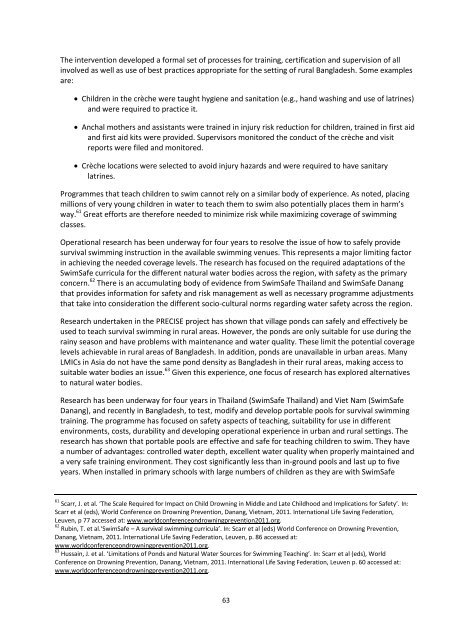Child Drowning
Child Drowning
Child Drowning
Create successful ePaper yourself
Turn your PDF publications into a flip-book with our unique Google optimized e-Paper software.
The intervention developed a formal set of processes for training, certification and supervision of all<br />
involved as well as use of best practices appropriate for the setting of rural Bangladesh. Some examples<br />
are:<br />
<strong>Child</strong>ren in the crèche were taught hygiene and sanitation (e.g., hand washing and use of latrines)<br />
and were required to practice it.<br />
Anchal mothers and assistants were trained in injury risk reduction for children, trained in first aid<br />
and first aid kits were provided. Supervisors monitored the conduct of the crèche and visit<br />
reports were filed and monitored.<br />
Crèche locations were selected to avoid injury hazards and were required to have sanitary<br />
latrines.<br />
Programmes that teach children to swim cannot rely on a similar body of experience. As noted, placing<br />
millions of very young children in water to teach them to swim also potentially places them in harm’s<br />
way. 61 Great efforts are therefore needed to minimize risk while maximizing coverage of swimming<br />
classes.<br />
Operational research has been underway for four years to resolve the issue of how to safely provide<br />
survival swimming instruction in the available swimming venues. This represents a major limiting factor<br />
in achieving the needed coverage levels. The research has focused on the required adaptations of the<br />
SwimSafe curricula for the different natural water bodies across the region, with safety as the primary<br />
concern. 62 There is an accumulating body of evidence from SwimSafe Thailand and SwimSafe Danang<br />
that provides information for safety and risk management as well as necessary programme adjustments<br />
that take into consideration the different socio-cultural norms regarding water safety across the region.<br />
Research undertaken in the PRECISE project has shown that village ponds can safely and effectively be<br />
used to teach survival swimming in rural areas. However, the ponds are only suitable for use during the<br />
rainy season and have problems with maintenance and water quality. These limit the potential coverage<br />
levels achievable in rural areas of Bangladesh. In addition, ponds are unavailable in urban areas. Many<br />
LMICs in Asia do not have the same pond density as Bangladesh in their rural areas, making access to<br />
suitable water bodies an issue. 63 Given this experience, one focus of research has explored alternatives<br />
to natural water bodies.<br />
Research has been underway for four years in Thailand (SwimSafe Thailand) and Viet Nam (SwimSafe<br />
Danang), and recently in Bangladesh, to test, modify and develop portable pools for survival swimming<br />
training. The programme has focused on safety aspects of teaching, suitability for use in different<br />
environments, costs, durability and developing operational experience in urban and rural settings. The<br />
research has shown that portable pools are effective and safe for teaching children to swim. They have<br />
a number of advantages: controlled water depth, excellent water quality when properly maintained and<br />
a very safe training environment. They cost significantly less than in-ground pools and last up to five<br />
years. When installed in primary schools with large numbers of children as they are with SwimSafe<br />
61 Scarr, J. et al. ‘The Scale Required for Impact on <strong>Child</strong> <strong>Drowning</strong> in Middle and Late <strong>Child</strong>hood and Implications for Safety’. In:<br />
Scarr et al (eds), World Conference on <strong>Drowning</strong> Prevention, Danang, Vietnam, 2011. International Life Saving Federation,<br />
Leuven, p 77 accessed at: www.worldconferenceondrowningprevention2011.org.<br />
62 Rubin, T. et al.‘SwimSafe – A survival swimming curricula’. In: Scarr et al (eds) World Conference on <strong>Drowning</strong> Prevention,<br />
Danang, Vietnam, 2011. International Life Saving Federation, Leuven, p. 86 accessed at:<br />
www.worldconferenceondrowningprevention2011.org.<br />
63 Hussain, J. et al. ‘Limitations of Ponds and Natural Water Sources for Swimming Teaching’. In: Scarr et al (eds), World<br />
Conference on <strong>Drowning</strong> Prevention, Danang, Vietnam, 2011. International Life Saving Federation, Leuven p. 60 accessed at:<br />
www.worldconferenceondrowningprevention2011.org.<br />
63

















